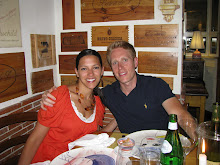From what I read, farro preempted the strains of wheat we're familiar with for mass consumption in Roman Italy and the reaches of its empire. The legions, properly nourished on this plump and chewy grain, were thus able to conquer many a foreign land. Then somewhere down the road they started cultivating higher yielding strains of wheat, and we all know what happened after that.
Artichokes are among my favorite vegetables to eat; I think maybe the work involved to get to the edible parts makes them more alluring to me. It's hard to put my finger on exactly what it is about the flavor I find so pleasing, but I know part of the enjoyment is the texture...eaten raw and sliced thin they are bitter but fresh, and cooked through they are tender yet firm enough to cut with a knife, mellow but distinct.
Baby artichokes are considerably less labor-intensive than mature ones because the leaves are not as fibrous to begin with, and the choke is not developed enough to be needly and bad for eating. They also tend to be cheaper by weight. The name though is misleading; these "babies" are full size when brought to market, just plucked lower on the plant than bigger ones.
This recipe might sound minimal and lacking pizzazz to some...if so, you could add olives and/or some fresh herbs like mint or parsley to liven it up, but for me just the aroma of good olive oil hitting the still warm farro as I mix it in gets me...adding artichokes, crispy and salty on the outside while sweet and tender within, is abundantly pleasing for a meal or at least a side.
2 lbs. baby artichokes, or equivalent in full size artichokes
16 oz. to 20 oz. Whole Farro
Hard, not too mild cheese like Pecorino Romano or Parmigiano Reggiano
3 to 4 tablespoons Extra Virgin Olive Oil, plus more to dress the farro
Juice of 2 lemons
3 cloves of garlic, smashed
Salt & pepper to taste
Hot pepper flakes to taste
Prepare the artichokes by peeling away the toughest outer layers of leaves...for mature artichokes this will require more work than baby artichokes, but they'll be tender enough when you reach the yellow/pale green layers. Cut away the outer flesh of the heart and stalk if it is intact. Then cut the artichoke in half, and if using mature ones, remove the thistles of the choke with a pairing knife or spoon.
Place the artichokes, cut side down, in a frying pan in one layer, along with the garlic, then add the olive oil and water to a depth of about a quarter inch and bring to a boil, covered. When the water boils, remove the lid and let the water evaporate as it steams the artichokes. Allow it to continue as the water disappears and the oil sizzles, browning and cooking the artichokes through. Cook until they are golden and crispy on the outside. Season to taste with salt and pepper.
You can choose to cook the farro per package instructions like a pilaf, but I just put it in a sauce pan and add cold water to cover by about 3 inches, then bring it to a boil (I don't pre-soak it either). I cook it at a moderate boil and taste for doneness about 30 minutes after initially turning the heat on, not from when it began boiling. I find it cooks in 30-40 minutes, start to finish. A couple minutes before it's done to your liking, add salt to the water, letting the salt dissolve and get absorbed by the grain, then checking for taste.
Drain the farro in a colander and let sit a 5 to 10 minutes to cool somewhat. Then place it in a serving bowl and add a few tablespoons at least of extra virgin olive oil. Add the artichokes and the lemon juice, and season to taste the salad with salt, pepper, and hot pepper flakes, tossing to mix everything in.
Serve with shavings of cheese and another generous drizzle of extra virgin olive oil.








No comments:
Post a Comment